Search the Site
Rider Balance Equals Safety (Current freebie!)
Balance in the saddle is a simple concept - but that doesn't mean it's necessarily easy to achieve. To be balanced on a horse a rider must follow this basic principle at all times:
The rider must keep their center of gravity directly over their base of support.
A person's center of gravity (hereafter COG) is exactly in the middle of their body, right behind their belly button. When standing on the ground, a person is in perfect balance if their COG is centered over the middle of their feet. If they lean foward so that their COG is over their toes, they are now slightly out of balance, and will have to use muscle strength to keep from falling over. Likewise if they lean backwards so that their COG is over the back of their feet, they also have to use muscles to keep from falling backwards, as they are slightly out of balance.
Look at this picture of a person performing a squat and think about what would happen to her if she brought her COG forward or backward from the middle balanced position that it is now:
The same is true on a horse. A rider must keep their COG over their base of support, which when riding without stirrups is the rider's seat. When riding with stirrups the base of support becomes the stirrups. Or somewhere in between when fully seated in the saddle.
Here is a drawing of perfect balance in the two point:
Notice that the rider's COG (upper red dot) is directly over their base of support (lower red dot). You get the sense in this drawing that if the horse magically disappeared out from under this rider, she would land on her feet in squat position. That describes perfect balance in a rider.
Also note that the rider's seat stays centered over the saddle, as it should be.
Here is a picture of a rider in perfect balance over a jump: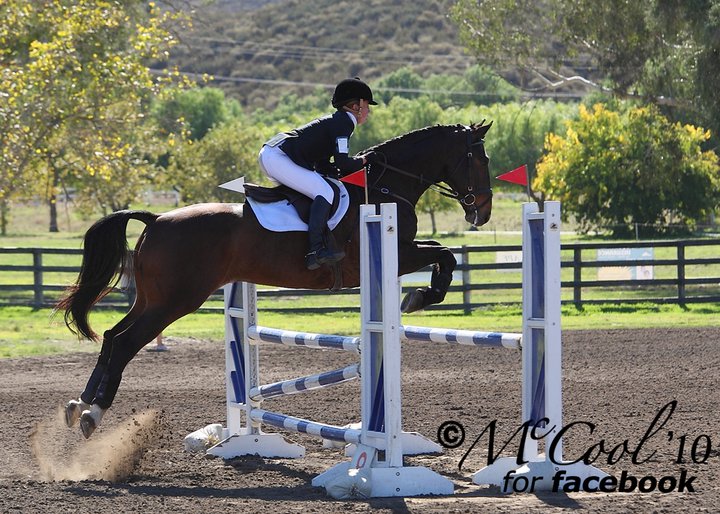
Now look at the picture below, which clearly shows the rider's COG well ahead of their base of support. This rider is out of balance, and needs to grip with her legs and use the reins or the horse's neck to stay in this position. You get the feeling that if her horse disappeared out from under her, she would fall face first. She is definitely in danger of falling off if her horse stops suddenly: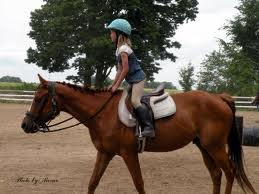
Here's another picture showing a rider whose COG is way too far forward ahead of their feet, this time over a jump: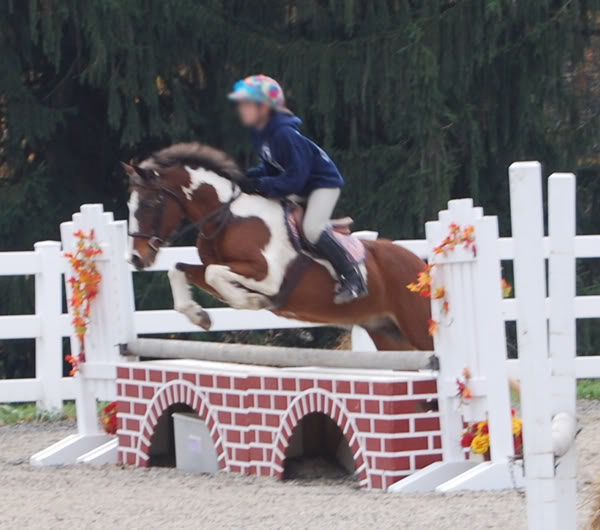
Notice how the riders' seats do not stay over the middle of the saddle in these two pictures, but rather go way up over the pommel. And as you can also see, when the rider's COG falls forward, their lower legs are free to fall back, compounding the problem. If these two young ladies didn't have her horses' necks to lean on, they'd be in trouble.
The next picture shows a rider who is falling backwards because their COG is well behind their feet. You get the feeling looking at this picture that if the horse were zapped out from under the rider, they would land on their backside. You also get the immpression that if the rider's reins were cut, they would flip off the back of the horse. As they are using the reins to avoid falling backwards.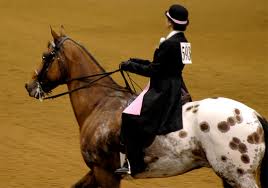
Now let's look at a picture of a rider being "left behind" over a jump, with their COG well behind their feet: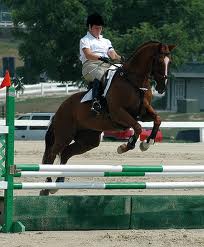
This rider is obviously way behind the motion, and is both catching the horse in the mouth and banging on it's back.
How is that different from the below picture showing a good defensive cross country position?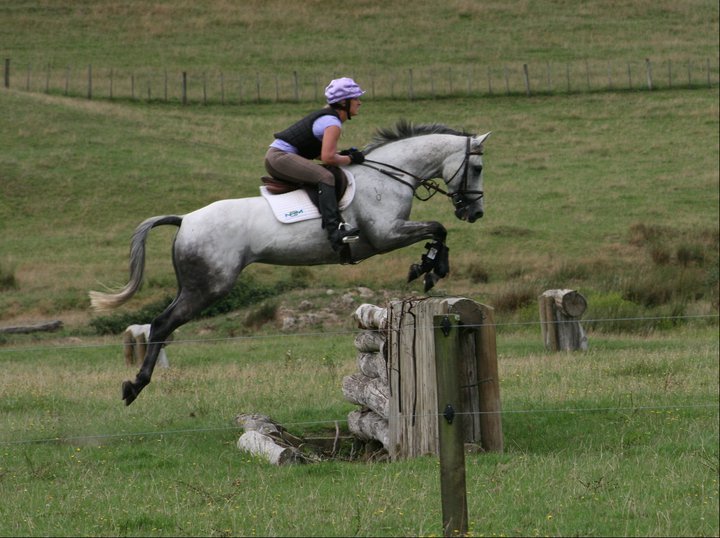
This rider has intentionally put their COG somewhat behind their base of support. It's a defensive or safety position that many riders adopt at times on cross country, to ensure safety at speed when the ground drops away, or the terrain makes it likely for the horse bobble on landing.
The difference between this picture and the one above it is that this rider is still giving the horse complete freedom, and upon landing will be right back with the motion. That is part of the art of cross country riding - developing the ability to put yourself a bit behind the motion when necessary, while not interfering with the horse in any way.
So there is a time and a place for a temporary deviation in the direction of the balance point tipping backwards. But there is no time that the balance point tipping forward is useful. That is only a dangerous and precarious position for a rider to be in.
Lets now discuss how a rider finds their balance. The best way is to take away the crutches, namely the reins and the horse's neck. Start at the halt if necessary. Go up into two point with your arms out to the side, and play around with different positions until you find your balance. If you are consistantly falling forward on the neck, move your hips back and your feet forward. If you are consistantly falling back in the saddle, bring your hips a bit more forward, and your legs back underneath you. When you are teetering back and forth between the two - you are close! Keep at it and you will find it.
When you have found a position that you can maintain with little muscular effort - where you feel like your seat is over the center of the saddle and very close to it, and you feel centered over your feet, you have found balance.
Now get someone to lunge you so that you can go through the same process of finding your balance with no reins at walk, trot, and canter. Be patient! It can take a while. You probably don't remember how you learned to balance youself when you first learned how to walk, or ride a bike. But you can bet that you probably teetered around quite a bit until you figured it out!
When you feel comfortable walk, trot, and canter with your arms out to the side, try it through little gymnastic grids. The kids usually like this exercise a whole lot more than the adults do! But there is no better way to find your balance independent of the horse when jumping.
There are many riders out there jumping decent size jumps and competing, who are not balanced independently of their horse, and would be lost without the reins or the horse's neck. The braver ones don't seem to care that their balance is precarious. The more timid become convinced that jumping is "too dangerous" and that they are not really cut out for it. And that is really unfortunate, as they would probably find it a lot more fun if they really had their balance.
Rider balance equals safety - and way more fun!






